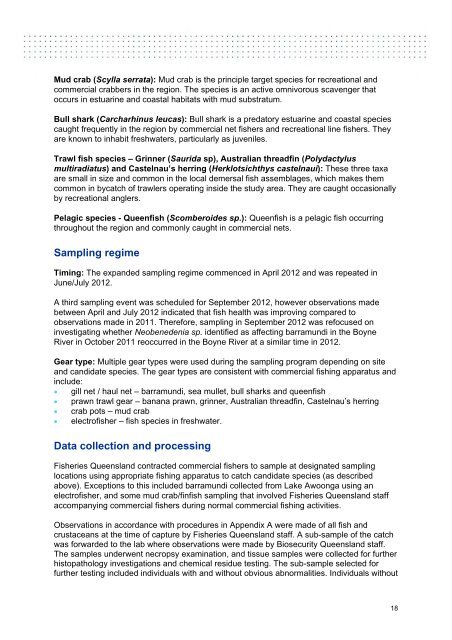Gladstone Fish Health Investigation 2011 - 2012 - Western Basin ...
Gladstone Fish Health Investigation 2011 - 2012 - Western Basin ...
Gladstone Fish Health Investigation 2011 - 2012 - Western Basin ...
Create successful ePaper yourself
Turn your PDF publications into a flip-book with our unique Google optimized e-Paper software.
Mud crab (Scylla serrata): Mud crab is the principle target species for recreational andcommercial crabbers in the region. The species is an active omnivorous scavenger thatoccurs in estuarine and coastal habitats with mud substratum.Bull shark (Carcharhinus leucas): Bull shark is a predatory estuarine and coastal speciescaught frequently in the region by commercial net fishers and recreational line fishers. Theyare known to inhabit freshwaters, particularly as juveniles.Trawl fish species – Grinner (Saurida sp), Australian threadfin (Polydactylusmultiradiatus) and Castelnau’s herring (Herklotsichthys castelnaui): These three taxaare small in size and common in the local demersal fish assemblages, which makes themcommon in bycatch of trawlers operating inside the study area. They are caught occasionallyby recreational anglers.Pelagic species - Queenfish (Scomberoides sp.): Queenfish is a pelagic fish occurringthroughout the region and commonly caught in commercial nets.Sampling regimeTiming: The expanded sampling regime commenced in April <strong>2012</strong> and was repeated inJune/July <strong>2012</strong>.A third sampling event was scheduled for September <strong>2012</strong>, however observations madebetween April and July <strong>2012</strong> indicated that fish health was improving compared toobservations made in <strong>2011</strong>. Therefore, sampling in September <strong>2012</strong> was refocused oninvestigating whether Neobenedenia sp. identified as affecting barramundi in the BoyneRiver in October <strong>2011</strong> reoccurred in the Boyne River at a similar time in <strong>2012</strong>.Gear type: Multiple gear types were used during the sampling program depending on siteand candidate species. The gear types are consistent with commercial fishing apparatus andinclude: gill net / haul net – barramundi, sea mullet, bull sharks and queenfish prawn trawl gear – banana prawn, grinner, Australian threadfin, Castelnau’s herring crab pots – mud crab electrofisher – fish species in freshwater.Data collection and processing<strong>Fish</strong>eries Queensland contracted commercial fishers to sample at designated samplinglocations using appropriate fishing apparatus to catch candidate species (as describedabove). Exceptions to this included barramundi collected from Lake Awoonga using anelectrofisher, and some mud crab/finfish sampling that involved <strong>Fish</strong>eries Queensland staffaccompanying commercial fishers during normal commercial fishing activities.Observations in accordance with procedures in Appendix A were made of all fish andcrustaceans at the time of capture by <strong>Fish</strong>eries Queensland staff. A sub-sample of the catchwas forwarded to the lab where observations were made by Biosecurity Queensland staff.The samples underwent necropsy examination, and tissue samples were collected for furtherhistopathology investigations and chemical residue testing. The sub-sample selected forfurther testing included individuals with and without obvious abnormalities. Individuals without18








